
Table of Contents
ToggleStretch marks are a common skin concern that many people experience at some point in their lives. These long, narrow streaks or stripes on the skin can appear in various areas of the body, such as the abdomen, thighs, hips, breasts, and arms. While stretch marks can come in different colors, including white and purple, many individuals wonder why stretch marks are often red in appearance.
The Formation of Stretch Marks
Before delving into the reasons behind the redness of stretch marks, it is important to understand how they form. Stretch marks, medically known as striae, occur when the skin is stretched beyond its normal capacity. This can happen due to rapid growth, weight gain, pregnancy, or hormonal changes.
When the skin stretches, the underlying connective tissues are disrupted, causing the collagen and elastin fibers to tear. As a result, the skin’s normal structure is compromised, leading to the formation of stretch marks. Initially, these marks may appear as raised or depressed streaks, which can be red, purple, or pink in color.
The Role of Blood Vessels
The primary reason why stretch marks are often red is the presence of blood vessels near the surface of the skin. When the skin stretches, it triggers an inflammatory response in the body. This response involves the dilation and increased blood flow to the affected area, which is why the stretch marks appear red.
The red coloration of stretch marks is due to the blood vessels becoming more visible through the thinning skin. Additionally, the inflammatory response can cause the blood vessels to leak small amounts of blood into the surrounding tissues, further intensifying the redness.
The Influence of Hormones
Hormonal changes play a significant role in the development and appearance of stretch marks. During periods of hormonal fluctuations, such as puberty, pregnancy, or certain medical conditions, the body’s production of hormones like cortisol increases.
Cortisol, known as the stress hormone, can weaken the skin’s collagen fibers and impair its elasticity. This makes the skin more susceptible to tearing and the formation of stretch marks. Moreover, increased cortisol levels can also cause blood vessels to dilate, contributing to the redness of stretch marks.
The Healing Process
Over time, the initial red or pink color of stretch marks may fade and become lighter. This change is primarily due to the healing process of the skin. As the tears in the dermis heal, the body produces new collagen fibers to repair the damaged area.
As the healing progresses, the blood vessels near the surface of the skin gradually shrink and become less visible. This results in the redness of stretch marks fading and transitioning to a lighter color, such as white or silver.
Managing the Appearance of Red Stretch Marks
While the redness of stretch marks may naturally diminish over time, some individuals may wish to expedite the process or reduce their visibility. Here are a few tips to help manage the appearance of red stretch marks:
- Moisturize: Regularly applying moisturizers or oils to the affected area can help improve the skin’s elasticity and reduce the redness of stretch marks.
- Topical treatments: Certain creams, lotions, and gels containing ingredients like retinol, hyaluronic acid, or vitamin C may help fade the redness of stretch marks.
- Laser therapy: Dermatological procedures, such as laser therapy, can stimulate collagen production and reduce the redness of stretch marks.
- Camouflage techniques: Using self-tanners or body makeup can help temporarily conceal the redness of stretch marks.
It is important to note that while these methods may improve the appearance of stretch marks, they may not completely eliminate them. Embracing and accepting one’s body is essential, as stretch marks are a natural part of life and do not define a person’s beauty or worth.
In Conclusion
Stretch marks are a common occurrence that can cause concern for many individuals. The redness of stretch marks is primarily due to the presence of blood vessels near the skin’s surface, as well as the inflammatory response triggered by the stretching of the skin. Hormonal changes and the healing process also contribute to the appearance and evolution of stretch marks.
While the redness of stretch marks may fade over time, various management techniques can help reduce their visibility. However, it is important to remember that stretch marks are a natural part of the body and should be embraced as a symbol of growth and change.
Understanding the science behind why stretch marks are red can help individuals feel more informed and empowered when it comes to their own bodies.








